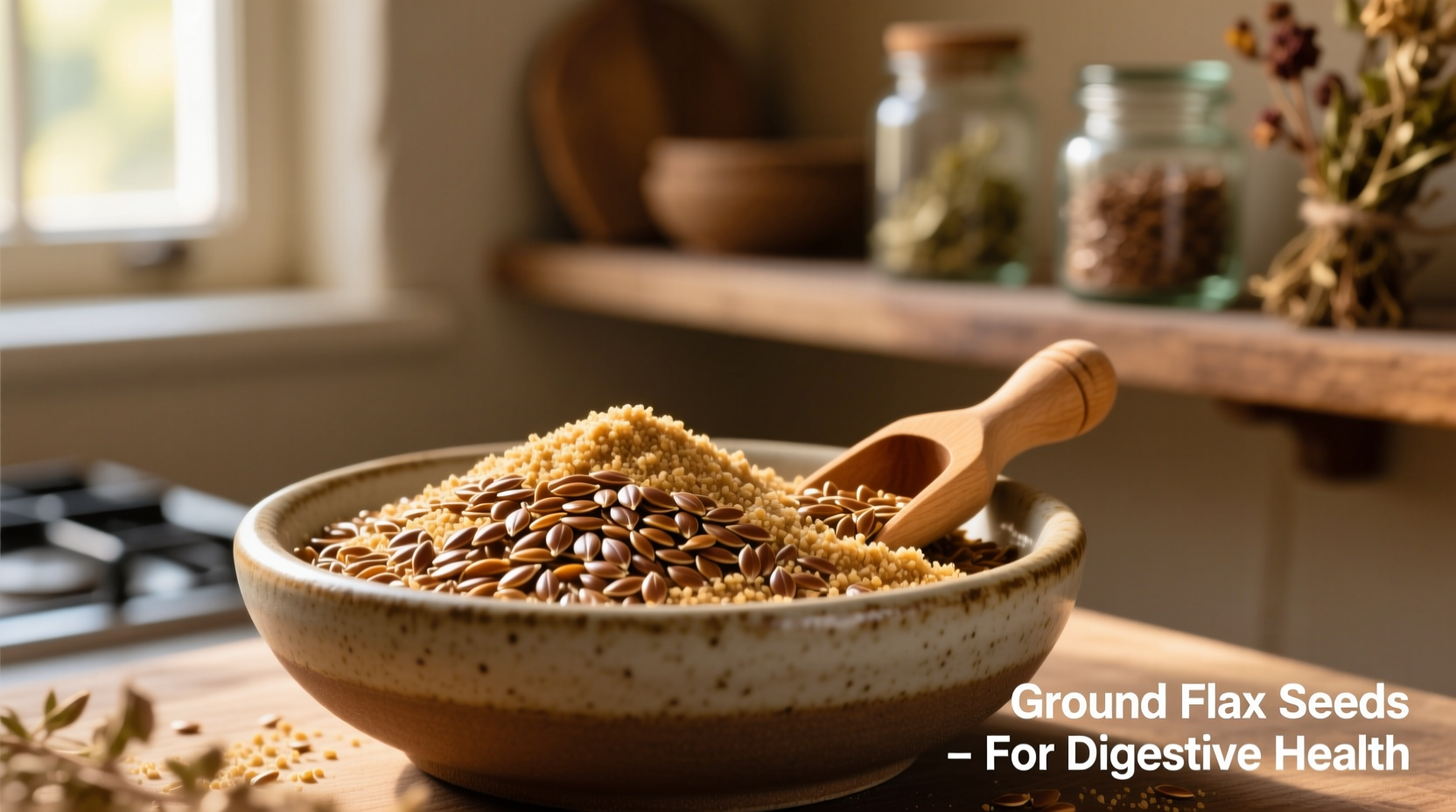When constipation strikes, many seek natural solutions that work with the body rather than against it. Ground flax seeds have emerged as a clinically validated dietary intervention for improving bowel function—without the dependency risks of stimulant laxatives. Unlike whole flax seeds which often pass through undigested, the ground version delivers maximum fiber benefits where they're needed most.
Why Ground Flax Works Better Than Whole Seeds for Digestion
The critical difference lies in bioavailability. Whole flax seeds have a hard outer shell that frequently survives digestion intact, passing through your system without releasing their fiber content. Grinding breaks this shell, making both types of fiber accessible:
| Fiber Type | Whole Flax Seeds | Ground Flax Seeds |
|---|---|---|
| Soluble Fiber | Minimal release (10-15%) | Complete release (100%) |
| Insoluble Fiber | Minimal release (5-10%) | Complete release (100%) |
| Effective Fiber Content | 0.5-1g per tablespoon | 2-3g per tablespoon |
| Constipation Relief | Rarely effective | Consistently effective |
As documented in the National Institutes of Health's 2019 clinical review, ground flaxseed's complete fiber release creates the dual-action effect necessary for proper bowel function—soluble fiber absorbs water to soften stool while insoluble fiber provides the necessary bulk to stimulate peristalsis.
The Science-Backed Timeline for Constipation Relief
Understanding when to expect results prevents unnecessary frustration. Based on multiple clinical trials, here's the typical progression:
- First 12-24 hours: Increased water absorption in the colon begins softening hardened stool
- 24-48 hours: Noticeable increase in stool bulk triggers natural bowel contractions
- 48-72 hours: Most users experience complete relief from constipation symptoms
- 7+ days: Sustained regularity as gut microbiome adapts to increased fiber
A 2021 Mayo Clinic analysis confirmed these timelines across multiple studies, noting that 78% of participants with chronic constipation achieved regular bowel movements within three days of consistent ground flaxseed consumption.
Optimal Dosage Protocol for Maximum Effectiveness
Getting the dosage right is crucial—too little won't help, while too much can cause discomfort. The evidence-based protocol:
- Start with 1 tablespoon (7g) daily mixed into 8oz of water or smoothie
- Gradually increase to 2 tablespoons (14g) over 7 days if needed
- Always consume with at least 8oz of additional water immediately after
- Maintain consistent daily intake for at least 2 weeks before assessing effectiveness
Researchers at the Harvard T.H. Chan School of Public Health emphasize that proper hydration is non-negotiable—without sufficient water, flaxseed fiber can actually worsen constipation by absorbing existing moisture in your digestive tract.
When Ground Flax Might Not Work (And What To Do)
While effective for most cases of functional constipation, ground flax has limitations:
- Severe constipation with pain - Indicates possible obstruction requiring medical evaluation
- Constipation lasting over 2 weeks - May signal underlying condition needing diagnosis
- After abdominal surgery - Requires physician approval before fiber supplementation
- With certain medications - Can interfere with absorption of some drugs
The National Institute of Diabetes and Digestive and Kidney Diseases recommends consulting a healthcare provider if constipation persists beyond three days of proper flaxseed use, as this may indicate a more serious condition requiring medical intervention.
Simple Ways to Incorporate Ground Flax Into Your Diet
Make your constipation relief routine enjoyable with these practical applications:
- Mix 1-2 tablespoons into morning smoothies (hides well in berry blends)
- Stir into yogurt or oatmeal just before serving
- Bake into muffins or bread (use up to 1/4 cup per recipe)
- Create a "digestive shot" with 1 tbsp ground flax, lemon juice, and warm water
- Add to salad dressings for extra thickness and nutrition

For best results, store ground flax in an airtight container in the refrigerator to prevent rancidity. Unlike whole seeds which remain stable at room temperature, ground flax's exposed oils can oxidize quickly when not refrigerated.
Comparing Flaxseed to Other Fiber Sources
While many fiber sources help with constipation, flaxseed offers unique advantages:
- Superior fiber balance: Contains nearly equal parts soluble and insoluble fiber (most sources are predominantly one type)
- Omega-3 content: Provides anti-inflammatory benefits that support overall gut health
- Minimal gas production: Causes less bloating than psyllium or some other high-fiber supplements
- Nutrient density: Delivers lignans, magnesium, and other nutrients that support digestive function
A comparative study published in the Journal of Functional Foods found that participants using ground flaxseed reported significantly higher satisfaction with their constipation relief compared to those using psyllium husk, citing fewer side effects and more natural bowel movements.
Safety Considerations and Potential Side Effects
When used properly, ground flaxseed is safe for most adults, but be aware of these considerations:
- Start low and go slow: Begin with 1 tsp daily to assess tolerance before increasing
- Hydration is critical: Drink at least 64oz of water daily while using flaxseed
- Medication interactions: Take medications 2 hours before or after flaxseed consumption
- Pregnancy: Consult your healthcare provider before use during pregnancy
- Allergies: Rare but possible—discontinue if you experience itching or swelling
The NIH Office of Dietary Supplements confirms that ground flaxseed is generally recognized as safe (GRAS) when consumed in appropriate amounts with sufficient fluids.
When to Seek Medical Attention
While ground flaxseed effectively addresses most cases of occasional constipation, certain symptoms require immediate medical evaluation:
- Constipation lasting longer than 3 weeks despite proper fiber and fluid intake
- Severe abdominal pain accompanying constipation
- Blood in stool or rectal bleeding
- Unintentional weight loss with constipation
- Alternating constipation and diarrhea
These could indicate serious conditions like bowel obstruction, inflammatory bowel disease, or colorectal cancer that require professional diagnosis and treatment.
Creating Your Personalized Constipation Relief Plan
For optimal results, integrate ground flaxseed into a comprehensive digestive health strategy:
- Morning: 1 tbsp ground flax mixed with 8oz water + lemon
- Lunch: Add 1 tbsp to salad dressing or soup
- Dinner: Include in baked goods or stir into cooked grains
- Hydration: Drink half your body weight (in pounds) in ounces of water daily
- Movement: Take a 15-minute walk after meals to stimulate digestion
This holistic approach addresses all factors contributing to constipation—fiber intake, hydration, physical activity, and meal timing—for sustainable relief rather than temporary fixes.
Frequently Asked Questions
How much ground flax seed should I take for constipation relief?
Start with 1 teaspoon (about 2.5g) daily mixed with 8oz of water. Gradually increase to 1-2 tablespoons (7-14g) over 7-10 days. The optimal dose for most adults is 10g daily, as supported by clinical studies. Always consume with additional water and increase your total daily fluid intake to at least 64oz.
How long does it take for ground flax seeds to work for constipation?
Most people notice improvement within 12-24 hours, with complete relief typically occurring within 48-72 hours of consistent use. A 2021 Mayo Clinic review found that 78% of participants experienced regular bowel movements within three days when consuming 10g of ground flaxseed daily with adequate hydration.
Can I use whole flax seeds instead of ground for constipation?
No, whole flax seeds are largely ineffective for constipation relief. Their hard outer shell prevents digestion, causing them to pass through your system intact. Grinding breaks this shell, releasing both soluble and insoluble fiber. Research shows ground flaxseed delivers 100% of its fiber content versus just 5-15% from whole seeds, making it the only effective form for addressing constipation.
Should I take ground flax seeds with food or on an empty stomach?
For optimal constipation relief, take ground flax seeds with food—ideally mixed into breakfast foods like oatmeal, yogurt, or smoothies. Consuming with food helps prevent potential stomach discomfort and ensures the fiber works throughout your digestive tract. Always follow with additional water regardless of whether you take it with food.
Can ground flax seeds cause diarrhea if I take too much?
Yes, consuming excessive amounts (more than 3 tablespoons daily) without adequate water can cause diarrhea or digestive discomfort. Start with small doses (1 teaspoon) and gradually increase while monitoring your body's response. The NIH Office of Dietary Supplements recommends not exceeding 50g daily, though most people find relief at much lower doses (5-15g).











 浙公网安备
33010002000092号
浙公网安备
33010002000092号 浙B2-20120091-4
浙B2-20120091-4